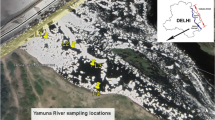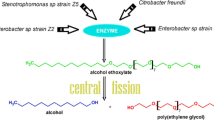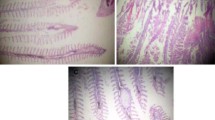Abstract
A bacterial community degrading branched alkylphenol ethoxylate (APE) was selected from coastal sea water intermittently polluted by urban sewage. This community degraded more than 99% of a standard surfactant, TRITON X 100, but I.R. analysis of the remaining compound showed the accumulation of APE2 (alkylphenol with a two units length ethoxylated chain) which seemed very recalcitrant to further biodegradation. Twenty-five strains were isolated from this community, essentially Gram negative and were related to Pseudomonas, Oceanospirillum or Deleya genera. Among these strains, only four were able to degrade APE9–10 (TRITON X 100). They were related to the Pseudomonas genus and were of marine origin. Pure cultures performed with these strains on TRITON X 100 gave APE5 and APE4 as end products. These products were further degraded to APE2 by two other strains unable to degrade the initial surfactant.
Similar content being viewed by others
References
Baleux B (1972) Dosage colorimétrique d'agents de surface non-ioniques polyoxyéthylénés à l'aide d'une solution iodo-iodurée. C.R. Acad. Sci. Paris. 274: 1617–1620.
Baumann P., LBaumann & MMandel (1971) Taxonomy of marine bacteria: the genus Beneckea. J. Bacteriol 107: 268–294.
Cain RB (1981) Microbial degradation of surfactants. In: Leisinger T, Cook AM, Hütter R, Nüesch J (Eds) Microbial Degradation of Xenobiotics and Recalcitrant Compounds. FEMS. Symposium No. 12 (pp 325–370). Academic Press, London.
Dorn PB, JPSalanitro, SHEvans & LKravetz (1993) Assessing the aquatic hazard of some branched and linear non-ionic surfactants by biodegradation and toxicity. Environ. Toxicol. Chem. 12: 1751–1762.
Ekelund R, AGranmo, KMagnusson & MBerggren (1993) Biodegradation of 4-nonylphenol in seawater and sediment. Environmental Pollution. 79: 59–61.
Frazee CD, QWOsburn & RDCrisler (1964) Application of infrared spectroscopy to surfactant degradation studies. JAOCS 41: 808–812.
Gerike P & WJakob 1988 Nonionic surfactants in the coupled units test. Tenside Surf. Deterg. 25: 166–168.
Maki H, NMasuda, YFujiwara, MIke & MFujita (1994) Degradation of alkylphenol ethoxylates by Pseudomonas sp. strain TR01. Applied Environ. Microbiol. 60: 2265–2271.
Mergaert J, CAnderson, AWouters, JSwings & KKersters (1992) Biodegradation of polyhydroxyalkanoates. FEMS Microbiol. Rev. 103: 317–321.
Osburn QW & JHBenedict (1966) Polyethoxylated alkylphenols: relationship of structure to biodegradation mechanism JAOCS 43: 143–146.
Patoczka J & GWPulliam (1990) Biodegradation and secondary effluent toxicity of ethoxylated surfactants. Water Res. 24: 965–972.
Pearce BA & MTHeydeman (1980) Metabolism of di(ethylene glycol) [2-(2′hydroxyethoxy)ethanol] and other short poly(ethylene glycol)s by gram negative bacteria. J. Gen. Microbiol. 118: 21–27.
Rhodes ME (1955) The cytology of Pseudomonas species as revealed by a silver plating staining method. J. Gen. Microbiol. 18: 639–648.
Ruiz Cruz J & LJaner del Valle (1986) Biodegradability determination by the E.E.C. Directives of non-ionic surfactants manufactured in Spain. Grasas Y Aceites. 37: 183–187.
Sigoillot JC & MHNguyen (1990) Isolation and characterization of surfactant degrading bacteria in a marine environment. FEMS Microbiol. Ecol. 73: 59–68.
Author information
Authors and Affiliations
Rights and permissions
About this article
Cite this article
Nguyen, M.H., Sigoillot, JC. Isolation from coastal sea water and characterization of bacterial strains involved in non-ionic surfactant degradation. Biodegradation 7, 369–375 (1996). https://doi.org/10.1007/BF00056420
Accepted:
Issue Date:
DOI: https://doi.org/10.1007/BF00056420




